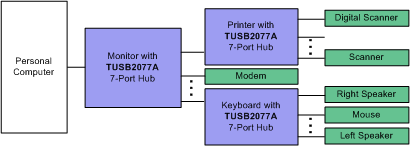SLLS414F March 2000 – August 2015 TUSB2077A
PRODUCTION DATA.
- 1 Features
- 2 Applications
- 3 Description
- 4 Revision History
- 5 Description (Continued)
- 6 Pin Configuration and Functions
- 7 Specifications
- 8 Detailed Description
- 9 Application and Implementation
- 10Power Supply Recommendations
- 11Layout
- 12Device and Documentation Support
- 13Mechanical, Packaging, and Orderable Information
Package Options
Refer to the PDF data sheet for device specific package drawings
Mechanical Data (Package|Pins)
- PT|48
Thermal pad, mechanical data (Package|Pins)
Orderable Information
1 Features
- Fully Compliant With the USB Specification as a Full-Speed Hub: TID #20240226
- Integrated USB Transceivers
- 3.3-V Low-Power ASIC Logic
- Two Power Source Modes
- Self-Powered Mode Supporting Seven Downstream Ports
- Bus-Powered Mode Supporting Four Downstream Ports
- All Downstream Ports Support Full-Speed and Low-Speed Operations
- Power Switching and Overcurrent Reporting Is Provided Ganged or Per Port
- Supports Suspend and Resume Operations
- Suspend Status Pin Available for External Logic Power Down
- Supports Custom Vendor ID and Product ID With External Serial EEPROM
- 3-State EEPROM Interface Allows EEPROM Sharing
- Push-Pull Outputs for PWRON Eliminate the Need for External Pullup Resistors
- Noise Filtering on OVRCUR Provides Immunity to Voltage Spikes
- Supports 6-MHz Operation Through a Crystal Input or a 48-MHz Input Clock
- New Functional Pins Introduced to Reduce the Board Material Cost
- 3 LED Indicator Control Outputs Enable Visualized Monitoring of 6 Different Hub/Port Status (HUBCFG, PORTPWR, PORTDIS)
- Output Pin Available to Disable External Pullup Resistor on DP0 for 15 ms After Reset or After Change on BUSPWR and Enable Easy Implementation of Onboard Bus/Self-Power Dynamic Switching Circuitry
- No Special Driver Requirements; Works Seamlessly With Any Operating System With USB Stack Support
- Available in 48-Pin LQFP Package
- JEDEC Descriptor S−PQFP−G for Low-Profile Quad Flatpack (LQFP).
2 Applications
- Computer Systems
- Docking Stations
3 Description
The TUSB2077A hub is a 3.3-V CMOS device that provides up to seven downstream ports in compliance with the USB 2.0 specification. Because this device is implemented with a digital state machine instead of a microcontroller, no software programming is required. Fully compliant USB transceivers are integrated into the ASIC for all upstream and downstream ports. The downstream ports support full-speed and low-speed devices by automatically setting the slew rate according to the speed of the device attached to the ports. The configuration of the BUSPWR terminal selects either the bus-powered or self-powered mode. The introduction of the DP0 pull-up resistor disable terminal, DP0PUR, makes it much easier to implement an onboard bus/self-power dynamic-switching circuitry. The three-LED indicator control output pins also enable the implementation of visualized status monitoring of the hub and its downstream ports. With these new function pins, the end equipment vendor can considerably reduce the total board cost while adding additional product value.
Device Information(1)
| PART NUMBER | PACKAGE | BODY SIZE (NOM) |
|---|---|---|
| TUSB2077A | LQFP (48) | 7.00 mm × 7.00 mm |
- For all available packages, see the orderable addendum at the end of the data sheet.
USB-Tiered Configuration Example
